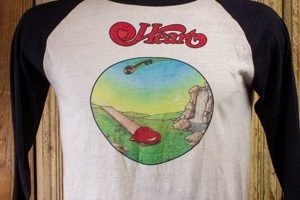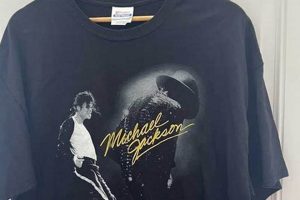Apparel featuring characters and artwork from older Japanese animated productions constitutes a specific category within the broader field of collectible clothing. These items often depict imagery from series that achieved popularity during the late 20th century. As an example, a garment displaying a character from a 1980s space opera, rendered in the style typical of that era, would fall into this classification.
The appeal of this particular segment of apparel lies in its connection to nostalgia, its representation of a specific cultural era, and its potential as a collectible item. Acquiring and wearing such pieces allows enthusiasts to express their affinity for classic animated shows and connect with shared cultural memories. Furthermore, the rarity of certain designs contributes to their value within collector communities, making them potentially appreciating assets.
The subsequent sections will delve into the factors that contribute to the desirability and value of these items, including identifying characteristics, preservation techniques, and the evolving market trends that influence their collectibility.
Valuable Insights for Acquiring Vintage Anime T Shirts
This section outlines crucial considerations for those seeking to acquire authentic and well-preserved examples of apparel featuring classic Japanese animation.
Tip 1: Scrutinize the Graphic Quality: Examine the printing. Faded, cracked, or poorly defined graphics can indicate significant wear or potential reproduction. A genuine older item will often exhibit subtle signs of age in the print, but the original artwork should remain discernible.
Tip 2: Assess the Fabric Composition and Stitching: The material used often reflects the manufacturing standards of the period. Heavier cotton fabrics and single-stitch construction are commonly associated with earlier productions. Inspect the seams for integrity and any signs of repair.
Tip 3: Verify Licensing and Copyright Marks: Authentic articles frequently bear licensing information from the animation studio or copyright holders. The presence, or absence, and accuracy of these marks can serve as indicators of legitimacy.
Tip 4: Consider the Tag and Label Details: Manufacturer labels and size tags provide valuable clues about the garment’s origin and era. Research specific tag styles associated with particular brands or time periods to aid in authentication.
Tip 5: Evaluate the Overall Condition Realistically: Imperfections such as minor staining or small holes are common in older clothing. Assess whether these flaws detract significantly from the item’s value or desirability. Severe damage should be a cause for concern.
Tip 6: Research Market Value and Rarity: Understanding the relative rarity of a particular design and its current market value is crucial. Consult auction records, online marketplaces, and collector communities to gauge a fair price.
Tip 7: Seek Expert Opinion When Necessary: For high-value or questionable items, consider consulting with an expert in vintage clothing or anime memorabilia. Their knowledge can provide valuable insights and prevent costly mistakes.
Adhering to these guidelines will increase the likelihood of acquiring authentic and desirable examples of apparel showcasing classic Japanese animation, while mitigating the risks associated with fraudulent or misrepresented items.
The final section will present advice on proper storage and care to maintain the condition and value of these cherished collectibles.
1. Authenticity Verification
The determination of a garment’s genuine origin as a product of its purported era is paramount in the realm of collectible apparel featuring classic Japanese animation. Authenticity verification acts as the foundational pillar upon which value and desirability are constructed. Without establishing the true age and manufacturing origin of an item, its status as a legitimate vintage piece remains questionable, potentially diminishing its worth significantly. The process involves a meticulous examination of various characteristics, including fabric composition, stitching techniques, graphic printing methods, and the presence of era-appropriate licensing and copyright information. A failure in any of these areas casts doubt on the item’s authenticity.
Consider a scenario involving two garments depicting imagery from a popular 1990s anime series. One possesses a single-stitch construction, a common feature of garments produced during that era, along with a faded yet legible copyright notice from the animation studio. The other exhibits a double-stitched hem, characteristic of more modern manufacturing, and lacks any discernible copyright information. While both pieces may appear visually similar, the former, verified through authenticating features, commands a higher value due to its genuine vintage status. The latter, lacking such verification, is relegated to the status of a reproduction or a more recent, less desirable item. Moreover, the ability to discern between genuine and counterfeit items protects collectors from fraud and ensures that investments are directed towards authentic pieces of historical and cultural significance.
In summation, rigorous authentication methods are integral to establishing the veracity and therefore the value of apparel showcasing classic Japanese animation. The examination of construction, materials, graphic techniques, and licensing details forms a crucial safeguard for collectors and enthusiasts. The presence of verifiable indicators distinguishes genuine artifacts from reproductions, solidifying their place within the collector’s market and preserving their cultural relevance.
2. Graphic condition
The condition of the printed imagery on garments featuring classic Japanese animation directly correlates with the item’s perceived value and collectibility. A pristine graphic, displaying vibrant colors and sharp details, significantly enhances desirability. Conversely, fading, cracking, peeling, or significant damage to the print drastically reduces its market value. The graphic represents the primary artistic and cultural element of the item; its degradation directly diminishes the aesthetic appeal and historical representation. As an example, a showing a clear depiction of characters from “Neon Genesis Evangelion” will fetch a higher price than the same garment with a heavily deteriorated print. The graphic serves as a visual benchmark of the garment’s age and its exposure to environmental factors. Preserving the integrity of this graphic is therefore paramount for maintaining the item’s status as a valuable collectible.
The relationship between wear and preservation techniques further influences the graphic’s condition. Excessive washing, exposure to sunlight, or improper storage practices contribute to accelerated deterioration. Certain printing methods, such as screen printing, are more susceptible to cracking over time than others. Understanding these factors allows collectors to adopt appropriate preservation strategies, such as hand-washing delicate items in cold water or storing them in acid-free containers away from direct sunlight. Preventative measures like these mitigate the degradation process, prolonging the lifespan and visual appeal of the artwork. Moreover, the presence of minor imperfections, while not ideal, can be considered acceptable in genuinely vintage pieces, provided the overall design remains discernible. A degree of fading or minor cracking might even add to the item’s perceived authenticity, distinguishing it from modern reproductions.
In conclusion, the graphic condition constitutes a critical factor in the valuation of apparel showcasing classic Japanese animation. Its impact on aesthetic appeal and historical representation dictates the item’s collectibility. While perfect condition is rare in vintage garments, proactive preservation efforts and a nuanced understanding of acceptable wear patterns are essential for maintaining the graphic’s integrity and maximizing the item’s long-term value. Discerning collectors must carefully assess the graphic, considering both its inherent artistic merit and its state of preservation, to make informed acquisition decisions.
3. Fabric composition
The constitution of the textile material utilized in apparel featuring classic Japanese animation serves as a critical determinant of its age, durability, and overall value. Assessing the fabric composition provides insight into manufacturing practices prevalent during different eras and informs judgements regarding authenticity and preservation strategies.
- Cotton Fiber Characteristics
Early garments frequently employed 100% cotton fabrics, often characterized by a heavier weight and a more open weave than contemporary textiles. The type of cotton used, such as ring-spun or open-end yarn, can further indicate the production period. For example, a piece utilizing a thick, unevenly textured cotton likely dates to an earlier period than one made with a smoother, lighter-weight cotton blend. The degradation patterns of cotton, such as yellowing or fiber breakdown, also provide clues about age and storage conditions.
- Blend Variations
The introduction of synthetic fibers, such as polyester, into fabric blends marked a significant shift in textile manufacturing. The presence and proportion of these synthetic elements can narrow down the production timeframe. A garment composed solely of cotton likely predates one incorporating a cotton-polyester blend. The feel and drape of the fabric, as well as its resistance to wrinkles and shrinkage, are further indicators of the fiber composition and its influence on the garment’s longevity.
- Stitching Techniques and Thread Type
Fabric composition influences the appropriate stitching techniques and thread types used in construction. Single-stitch construction, where a single line of stitching secures the seams, is commonly associated with older apparel. The type of thread used, whether cotton or synthetic, also correlates with the era of production. A garment exhibiting single-stitch construction with cotton thread aligns with earlier manufacturing practices, while double-stitched seams with synthetic thread suggest a more recent origin.
- Dye Absorption and Retention
The fabric composition directly impacts the absorption and retention of dyes used in printing graphic designs. Natural fibers like cotton tend to absorb dyes more readily than synthetic fibers. The extent to which a garment has retained its original color vibrancy, or conversely, the degree of fading present, can be linked to the fabric composition and its interaction with the dyes used. Garments made with natural fibers may exhibit a more nuanced and faded appearance over time, while those with synthetic components may retain color longer but potentially display less natural aging patterns.
In conclusion, the fabric composition serves as a reliable indicator of the age and origin of apparel showcasing classic Japanese animation. Examining the fiber type, blend variations, stitching techniques, and dye retention characteristics allows for a more informed assessment of authenticity and contributes to effective preservation strategies, ultimately impacting the item’s value and historical significance.
4. Copyright markings
Copyright markings constitute a critical element in establishing the authenticity and provenance of apparel featuring classic Japanese animation. These markings, typically comprising a copyright symbol (), the copyright holder’s name, and the year of publication, function as legally enforceable indicators of ownership and protect intellectual property. Their presence on an item provides a tangible link to the original source material and production era, significantly enhancing its value within the collector’s market. For instance, a displaying imagery from “Mobile Suit Gundam” bearing a clear Sotsu Agency/Sunrise copyright notice from the 1980s lends credence to its claimed vintage status. The absence of such markings, conversely, raises suspicion of unauthorized reproduction or modern manufacture. The accuracy and consistency of the copyright information, including the specific phrasing and format, are crucial factors in the authentication process. Discrepancies or inconsistencies can indicate a counterfeit or unlicensed product.
The significance of copyright markings extends beyond mere authentication; they also provide valuable context regarding the item’s historical and cultural background. The copyright holder’s name identifies the entity responsible for the intellectual property, be it the animation studio, production company, or individual artist. The publication year indicates the period during which the artwork was created and distributed, placing the garment within a specific timeframe. This information allows collectors to trace the item’s origins and understand its relationship to the broader landscape of anime history. Moreover, the presence of a recognized copyright mark signifies that the garment was officially licensed and distributed, further validating its authenticity and quality. Unlicensed or bootleg items, lacking these markings, are generally considered less desirable due to their uncertain origins and potential lack of quality control.
In summary, copyright markings represent an indispensable tool for verifying the authenticity and assessing the value of apparel featuring classic Japanese animation. Their presence serves as a legally recognized indicator of ownership and origin, providing crucial context regarding the item’s historical and cultural significance. Collectors should carefully examine copyright information, ensuring its accuracy, consistency, and alignment with established historical records. A thorough understanding of copyright markings empowers collectors to make informed acquisition decisions and safeguard against fraudulent or misrepresented items, preserving the integrity of the vintage anime collectible market.
5. Market valuation
The economic worth assigned to apparel featuring classic Japanese animation is subject to fluctuating market dynamics, making valuation a complex process requiring an understanding of several key factors. Assessing the fair exchange value necessitates careful consideration of scarcity, condition, historical significance, and prevailing collector demand.
- Rarity and Scarcity Influence
The limited availability of a specific design directly impacts its market price. Items produced in small quantities or those that have survived from earlier eras in good condition command higher valuations. Factors contributing to scarcity include limited-edition releases, regional exclusivity, or attrition due to wear and tear over time. For example, a garment featuring a character from a niche anime series that was only available in Japan during its initial release will generally be more valuable than a mass-produced item from a widely popular series.
- Condition and Preservation Premium
The physical state of the collectible significantly affects its market value. Pristine, unworn items, especially those with original tags intact, fetch the highest prices. Even slight imperfections, such as fading, staining, or minor damage, can reduce the valuation. The extent of the damage, its location on the garment, and the ease of potential restoration influence the magnitude of the devaluation. Garments that have been properly stored and cared for, preserving their original color and structure, maintain a higher market value.
- Nostalgia and Cultural Significance Factor
The degree to which an item resonates with nostalgia and represents a significant cultural moment contributes to its market appeal. Apparel featuring characters from iconic anime series that defined a generation often command higher prices due to their sentimental value. The garment’s association with a specific cultural trend or historical event can further enhance its desirability among collectors. Demand often increases when a particular anime series experiences a resurgence in popularity, driven by remakes, sequels, or renewed interest in classic titles.
- Provenance and Authenticity Documentation Value
Establishing the genuine origin and historical context of a garment significantly impacts its market valuation. Items with documented provenance, such as verifiable purchase receipts, photographs, or testimonials from previous owners, gain credibility and increase in value. Certification from reputable authentication services further solidifies the item’s authenticity and reassures potential buyers. Clear and verifiable copyright markings also contribute to establishing the garment’s legitimate origin, enhancing its market appeal.
These factors, working in concert, determine the economic worth of apparel showcasing classic Japanese animation. Variations in scarcity, condition, cultural resonance, and proven authenticity create a wide spectrum of market values. An understanding of these principles enables collectors and investors to make informed decisions, maximizing their returns while preserving these unique cultural artifacts.
Frequently Asked Questions
This section addresses common inquiries regarding apparel featuring classic Japanese animation, providing factual information to assist collectors and enthusiasts.
Question 1: What defines an article of clothing as “vintage” in this context?
Generally, items manufactured at least twenty years prior to the present day are classified as vintage. However, collectibility also depends on the item’s design, rarity, and cultural significance. A item from 2003 featuring a less popular anime may be considered vintage, but not necessarily collectible.
Question 2: How can the authenticity of a design be verified?
Verification involves examining several factors: fabric composition, stitching techniques (e.g., single-stitch construction), presence and accuracy of copyright markings, and consistency of the graphic style with the purported era. Expert consultation may be required for high-value or ambiguous items.
Question 3: What are the most common condition issues affecting these items?
Fading, cracking of the graphic print, staining, small holes, and general wear are frequently encountered. The impact of these issues on value depends on their severity and location on the garment.
Question 4: How should these items be properly stored to prevent damage?
Optimal storage involves keeping garments in a cool, dry place away from direct sunlight. Acid-free containers or archival-quality garment bags are recommended. Folding is preferable to hanging, as hanging can stretch the fabric over time.
Question 5: What factors influence the market value of such pieces?
Scarcity, condition, historical significance, and prevailing collector demand are key determinants. Limited-edition designs in excellent condition associated with popular anime series tend to command higher prices.
Question 6: Where can genuine examples of apparel showcasing classic Japanese animation be acquired?
Reputable vintage clothing stores, online auction sites, specialty collectible marketplaces, and anime conventions represent potential sources. Due diligence and careful examination are essential when purchasing from any source.
Careful examination of authenticity markers, proactive storage solutions, and a discerning understanding of market dynamics are fundamental to collecting valuable garments featuring artwork from classic Japanese animation.
The subsequent sections will explore preservation and restoration techniques in greater detail.
Conclusion
The preceding analysis has explored the multifaceted nature of “vintage anime t shirts,” emphasizing the pivotal role of authenticity verification, graphic assessment, fabric composition analysis, copyright confirmation, and market valuation in determining their desirability and worth. The investigation underscores the blend of cultural significance, historical context, and material characteristics that influence the value of these collectible artifacts.
Continued scrutiny and informed acquisition practices are essential for both preserving the integrity of this niche market and ensuring that these cultural emblems are protected for future appreciation. Further research and diligent application of the outlined principles will serve to enhance understanding and responsible stewardship within the community of collectors and enthusiasts.







